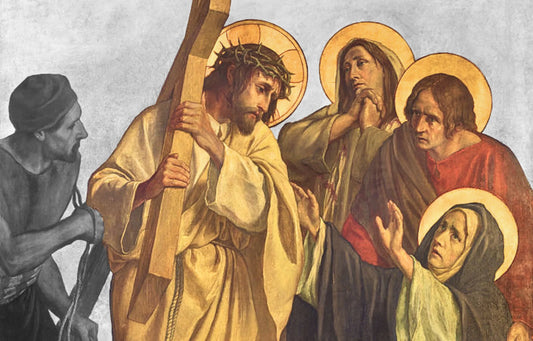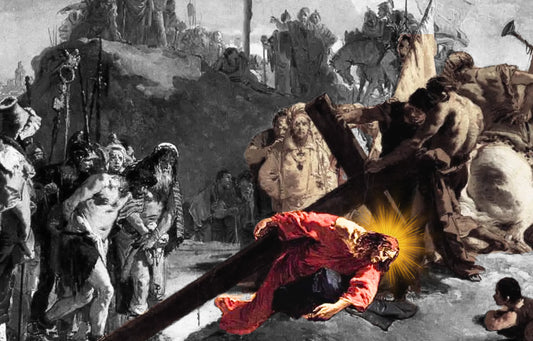Red appears over 50 times in Scripture, symbolizing blood (Exodus 12:13), sin (Isaiah 1:18), sacrifice (Leviticus 17:11), and redemption through Christ (Revelation 5:9). It’s the color of the Passover lamb’s blood and the scarlet stain of sin turned white. Red encapsulates the tension between divine wrath and saving grace.
As Old Testament scholar Nahum Sarna notes, “blood in the biblical world is not simply a fluid but a sacred element that seals covenants and mediates divine-human relationships” (JPS Torah Commentary: Exodus, 1991).
The Color Red in Biblical Languages
Hebrew: Adom, Dam, and Adam
In Hebrew, אָדוֹם (adom, red) shares a root with דָּם (dam, blood), linking color and life at the linguistic level. Even Adam (אָדָם), the first human, derives from אֲדָמָה (adamah, red earth), underscoring humanity’s origin from blood-colored soil (Genesis 2:7).
As Wilhelm Gesenius points out, these roots emphasize the theological belief that “man is earth-formed and life-blooded” (Hebrew and Chaldee Lexicon, 1847). In Jewish thought, red isn't just visual—it’s elemental.
Greek: Pyrrhos and Revelation Imagery
In the Greek New Testament, πυρρός (pyrrhos) refers to fiery red and appears in Revelation 6:4, describing the red horse of war—a vivid image of bloodshed and divine judgment.
According to G.K. Beale, “red in apocalyptic literature connotes wrath, turmoil, and the shedding of blood in the eschatological drama” (Revelation: A Commentary on the Greek Text, 1999). It’s the color of crisis at the world’s spiritual breaking point.
The Power and Symbolism of Red in Scripture
Red is one of Scripture’s most loaded symbols, marking moments of covenant, sacrifice, sin, and cleansing. From adom to kokkinos, the color carries intense theological weight across cultures and covenants.
The Mishnah (Yoma 6:6) records a red thread tied to the scapegoat on Yom Kippur—symbolizing Israel’s sin. According to rabbinic tradition, the thread turned white when atonement was accepted, echoing Isaiah 1:18.
N.T. Wright affirms that “Jesus’ blood speaks of both judgment and covenantal faithfulness” (The Day the Revolution Began, 2016). Red in Scripture is never aesthetic—it marks moments when God moves decisively in history to redeem, judge, or restore.
Red as Blood and Sacrifice: The Pulse of Divine Life
In ancient Israelite theology, blood is the essence of life itself. Leviticus 17:11 famously states, “For the life of the flesh is in the blood,” a declaration that elevated blood from mere bodily fluid to sacred substance. This belief underpinned all sacrificial systems.
The pivotal moment comes in Exodus 12:13, where the Israelites mark their doorposts with the blood of a spotless lamb during the first Passover in around 1446 BC (traditional dating). This act of protection from death not only saved Israel but prefigured the ultimate sacrifice of Christ, the “Lamb of God” (John 1:29).
The New Testament deepens this symbolism: Hebrews 9:22 declares unequivocally that “without the shedding of blood there is no forgiveness.” Jesus’ sacrificial death on the cross fulfills and surpasses all previous sacrifices, his blood sealing the New Covenant (Luke 22:20). This covenant through blood marks the transition from ritual purity laws to spiritual redemption.
Red and Sin: Scarlet Stains and the Promise of Purification
The color red vividly represents sin’s stain in Scripture, but it also offers hope. Isaiah’s poetic invitation in Isaiah 1:18—“Though your sins are like scarlet, they shall be as white as snow”—uses scarlet as a metaphor for guilt and impurity. This striking image encapsulates both the reality of sin’s deep corruption and the possibility of divine cleansing.
Similarly, Rahab’s scarlet cord in Joshua 2:18, hanging in Jericho’s window, becomes a lifeline—a symbol of salvation amidst judgment. This single strand of red thread carries rich theological meaning: sin and salvation are interwoven, and God’s grace reaches even into places marked by rebellion.
Biblical scholars like John Goldingay emphasize that scarlet’s vividness reflects sin’s visible consequences in the community and individual lives, making it impossible to ignore.
Red as Divine Wrath and Judgment: The Fierce Flame
Red also embodies God’s righteous judgment. The apocalyptic imagery in Revelation 6:4, where a rider on a red horse is given power to “take peace from the earth,” symbolizes violent conflict and divine wrath during the end times.
The Old Testament prophet Nahum graphically describes battle scenes with shields “red with glowing metal,” evoking bloodshed and destruction (Nahum 2:3). This fiery red connotes both divine anger against sin and the sobering reality of justice.
The “scarlet beast” in Revelation 17:3 further dramatizes red as a symbol of worldly corruption and judgment. The biblical narrative warns that unchecked sin leads to ruin, using red’s vividness as a stark reminder.
Covenant Blood: The Sacred Seal of God’s Promise
Blood is inseparable from covenant in biblical theology. In Genesis 15:9-10, God instructs Abraham to bring sacrificial animals to ratify their covenant. The “cutting” of animals and the passing between pieces symbolizes a solemn and life-binding agreement sealed with blood.
This motif culminates in the New Testament’s “blood of the covenant” referenced by Jesus at the Last Supper (Matthew 26:28). This sacrificial blood inaugurates a new relationship between God and humanity, founded not on law but on grace and mercy.
Red in Sacred Spaces: Priestly Garments and the Tabernacle
The Book of Exodus (chapters 26-28) details the use of red yarn in the Tabernacle curtains and priestly vestments. This red dye, often derived from the costly tekhelet (blue) and argaman (purple), was reserved for holy use, signifying life and sacrifice.
The intertwining of red with blue and purple reflected a divine hierarchy—red representing sacrifice and atonement, blue the heavens, and purple royalty. Thus, the red thread in the Tabernacle was a tangible reminder that holiness requires the costly gift of life.
The Red Heifer: A Ritual of Purification and Prophetic Significance
The red heifer ritual in Numbers 19, performed around the wilderness period (approx. 1400 BC), involved sacrificing a flawless red cow, whose ashes purified those defiled by death. This ceremony illustrates the paradox of purification: the use of death to cleanse.
Many theologians see in this ritual a prophetic shadow of Christ’s atoning death. Just as the ashes of the red heifer purified, so Christ’s blood purifies believers from sin and death (Hebrews 9:13-14).
Cultural Context: Red in the Ancient Near East
Red’s biblical symbolism is enriched by its broader Ancient Near Eastern context. Semitic cultures associated red with vitality, danger, and divine power. Egyptian tombs reveal use of red ochre in burial rites, symbolizing life and protection against evil.
By appropriating and redefining these symbols, Israelite religion emphasized God’s unique covenantal presence, blending familiar cultural signs with monotheistic theology.
New Testament Theology: Redemption Through Blood
The New Testament intensifies red’s meaning. Paul writes in Ephesians 1:7 that believers have redemption through Christ’s blood, highlighting grace and forgiveness. Peter describes salvation as “purchased with the precious blood of Christ” (1 Peter 1:18-19), affirming the invaluable cost.
The theme of martyrdom also incorporates red: Revelation celebrates the “blood of the martyrs” as a testament to faith and spiritual victory (Revelation 12:11). Red here symbolizes ultimate witness—life given for truth.
Apocalyptic and Eschatological Imagery of Red
The prophetic and apocalyptic books use red to symbolize cosmic upheaval. The “blood moon” prophecy in Joel 2:31 and echoed in Acts 2:20 signals the approaching Day of the Lord, a time of judgment and renewal.
Revelation’s red horse and scarlet beast intensify this imagery, portraying bloodshed and sin’s climax before final judgment. This apocalyptic use of red demands sober reflection on human history and divine sovereignty.
Quick Biblical References to the Color Red
Life, Blood, and Sacrifice
Leviticus 17:11 – “The life of the flesh is in the blood.” Red symbolizes life itself, foundational for sacrifice and covenant.
Exodus 12:13 – Blood on doorposts during Passover protects Israel, marking the power of sacrificial blood to save.
Hebrews 9:22 – “Without the shedding of blood, there is no forgiveness,” emphasizing blood as the key to atonement.
Sin and Guilt Symbolized by Scarlet
Isaiah 1:18 – “Though your sins are like scarlet, they shall be as white as snow.” Scarlet vividly represents sin’s stain but also God’s cleansing power.
Joshua 2:18 – Rahab’s scarlet cord signals salvation amid judgment, showing red as a symbol of hope within danger.
Wrath, War, and Judgment
Revelation 6:4 – The red horse of war brings bloodshed and conflict, showing red as divine judgment’s color.
Nahum 2:3 – Shields stained red with blood depict violent divine wrath.
Revelation 17:3 – The scarlet beast represents corruption and impending doom.
Covenant and Divine Promise
Genesis 15:9–10 – Covenant sealed by the blood of sacrificed animals; red here is a sacred sign of solemn agreement.
Matthew 26:28 – Jesus calls His blood “the blood of the covenant,” inaugurating a new relationship with God.
Purification and Holiness
Numbers 19 – The red heifer’s ashes purify the ritually unclean, highlighting red as a symbol of cleansing and restoration.
Exodus 26–28 – Red yarn in the Tabernacle and priestly garments symbolizes holiness through sacrifice, woven into divine worship.
Applying the Symbolism of Red to Christian Life
Just as red blood sustains physical life, spiritual life depends on Christ’s sacrifice. Red calls Christians to recognize sin’s seriousness, the cost of grace, and the power of redemption. It challenges believers to embrace repentance and covenant faithfulness. Red also warns of judgment, urging holy living and trust in God’s mercy. Ultimately, red symbolizes the fiery love of God poured out for humanity—inviting us to live lives marked by sacrificial love, courage, and hope.














